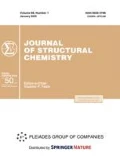Abstract
IR spectroscopy and density functional theory (B3LYP/6-31++G(d, p)) are used to study the competition between methanol and water molecules during the formation of (CH3(H)O∙∙∙H∙∙∙O(H)CH3)+, (CH3(H)O∙∙∙H∙∙∙OH2)+, and (H2O∙∙∙H∙∙∙OH2)+ ions with strong quasi-symmetrical H-bonds and their solvation in the CH3OH–H2O–HCl system. When water is added to a solution of HCl in methanol, H2O molecules substitute CH3OH molecules in (CH3(H)O∙∙∙H∙∙∙O(H)CH3)+ ions to form mixed disolvates. Conversely, when methanol is added to an aqueous solution of HCl, (H2O∙∙∙H∙∙∙OH2)+ ions are maintained and CH3OH molecules are involved in their solvation. Provided that the fractions of methanol and water are commensurate, the solutions contain simultaneously (CH3(H)O∙∙∙H∙∙∙OH2)+ and (H2O∙∙∙H∙∙∙OH2)+ ions. The ratio between their concentrations depends on the content of HCl in the system. It is shown that the energy of the hydrogen bond system per one dissociated HCl molecule is the main factor determining the structure of CH3OH–H2O–HCl solutions, in particular, the composition of proton disolvates.







Similar content being viewed by others
Notes
This change means that the gas phase does not provide the formation of disolvates where isomer 2CH3OH·(H2O⋯H⋯O(H)CH3)+·H2O interacts with anion Cl− via the CH group of the ion and the OH group of the solvating water molecule.
Complex 15 with similar bonds was not considered, since its ΔEcom is affected by additional intermolecular interactions within the isomers.
REFERENCES
G. Zundel and H. Metzger. Z. Phys. Chem., 1968, 58, 225.
N. B. Librovich, V. D. Maiorov, and V. A. Savel′ev. Dokl. Akad. Nauk SSSR, 1975, 225(6), 1358.
A. A. Pankov, V. Yu. Borovkov, and V. B. Kazanskii. Dokl. Akad. Nauk SSSR, 1981, 258, 902.
G. V. Yukhnevich, E. G. Tarakanova, V. D. Maiorov, and N. B. Librovich. Usp. Khim., 1995, 64(10), 901.
M. V. Vener and N. B. Librovich. Int. Rev. Phys. Chem., 2009, 28(3), 407.
N. B. Librovich, V. V. Burdin, V. D. Maiorov, and I. S. Kislina. Chem. Phys. Rep., 2001, 19(4), 757.
V. D. Maiorov, I. S. Kislina, A. A. Rykounov, and M. V. Vener. J. Phys. Org. Chem., 2014, 27, 135.
V. D. Maiorov, G. I. Voloshenko, N. B. Librovich, and M. I. Vinnik. Izv. Akad. Nauk, Ser. Khim., 1992, (10), 2261.
V. V. Burdin, V. D. Maiorov, G. I. Voloshenko, O. Yu. Antonova, and N. B. Librovich. Russ. Chem. Bull., 1998, 47(12), 2415.
V. D. Maiorov, G. I. Voloshenko, and N. B. Librovich. Chem. Phys. Rep., 1994, 13(1), 219.
V. D. Maiorov, I. S. Kislina, G. I. Voloshenko, E. G. Tarakanova, and G. V. Yukhnevich. Khim. Fiz., 2012, 31(9), 28.
E. G. Tarakanova and G. V. Yukhnevich. J. Struct. Chem., 2008, 49(4), 679.
E. G. Tarakanova and G. V. Yukhnevich. Rus. J. Inorg. Chem., 2018, 63(4), 549.
V. D. Maiorov, I. S. Kislina, and E. G. Tarakanova. Rus. J. Phys. Chem. B, 2017, 11(1), 37.
V. D. Maiorov, G. I. Voloshenko, I. S. Kislina, and E. G. Tarakanova. Khim. Fiz., 2020, 39(1), 7.
E. G. Tarakanova, G. I. Voloshenko, I. S. Kislina, V. D. Maiorov, G. V. Yukhnevich, and A. K. Lyashchenko. J. Struct. Chem., 2019, 60(2), 255.
E. G. Tarakanova, G. V. Yukhnevich, I. S. Kislina, and V. D. Maiorov. Phys. Wave Phenom., 2020, 28(2), 168.
N. B. Librovich, V. D. Maiorov, and M. I. Vinnik. J. Struct. Chem., 1973, 14(1), 17.
N. J. Harrick. Internal Reflection Spectroscopy. J. Wiley Intersci.: N.Y., 1967.
M. J. Frisch, G. W. Trucks, H. B. Schlegel, G. E. Scuseria, M. A. Robb, J. R. Cheeseman, G. Scalmani, V. Barone, B. Mennucci, G. A. Petersson, H. Nakatsuji, M. Caricato, X. Li, H. P. Hratchian, A. F. Izmaylov, J. Bloino, G. Zheng, J. L. Sonnenberg, M. Hada, M. Ehara, K. Toyota, R. Fukuda, J. Hasegawa, M. Ishida, T. Nakajima, Y. Honda, O. Kitao, H. Nakai, T. Vreven, J. A. Montgomery, J. E. Peralta, F. Ogliaro, M. Bearpark, J. J. Heyd, E. Brothers, K. N. Kudin, V. N. Staroverov, R. Kobayashi, J. Normand, K. Raghavachari, A. Rendell, J. C. Burant, S. S. Iyengar, J. Tomasi, M. Cossi, N. Rega, J. M. Millam, M. Klene, J. E. Knox, J. B. Cross, V. Bakken, C. Adamo, J. Jaramillo, R. Gomperts, R. E. Stratmann, O. Yazyev, A. J. Austin, R. Cammi, C. Pomelli, J. W. Ochterski, R. L. Martin, K. Morokuma, V. G. Zakrzewski, G. A. Voth, P. Salvador, J. J. Dannenberg, S. Dapprich, A. D. Daniels, O. Farkas, J. B. Foresman, J. V. Ortiz, J. Cioslowski, and D. J. Fox. Gaussian 09, Revision A.02. Gaussian, Inc.: Wallingford CT, 2009.
V. D. Maiorov, N. B. Librovich, and M. I. Vinnik. Izv. Akad. Nauk SSSR, Ser. Khim., 1979, (2), 281.
Funding
The IR spectra were measured and analyzed within the RAS Basic Research Program of FRC CP RAS “Fundamental laws of heterogeneous and homogeneous catalysis”, theme No. 46.13. The DFT study of the competition between \({{\text{H}}_{5}}\text{O}_{2}^{+}\) and (H2O⋯H⋯O(H)CH3)+ ions in CH3OH–H2O–HCl solutions was performed within the Government Contract of IGIC RAS in the field of fundamental research.
Author information
Authors and Affiliations
Corresponding author
Ethics declarations
The authors declare that they have no conflict of interests.
Rights and permissions
About this article
Cite this article
Tarakanova, E.G., Maiorov, V.D., Voloshenko, G.I. et al. COMPETITION BETWEEN METHANOL AND WATER MOLECULES UPON THE FORMATION AND SOLVATION OF IONS IN THE CH3OH–H2O–HCl SYSTEM. J Struct Chem 61, 1910–1923 (2020). https://doi.org/10.1134/S0022476620120082
Received:
Revised:
Accepted:
Published:
Issue Date:
DOI: https://doi.org/10.1134/S0022476620120082


